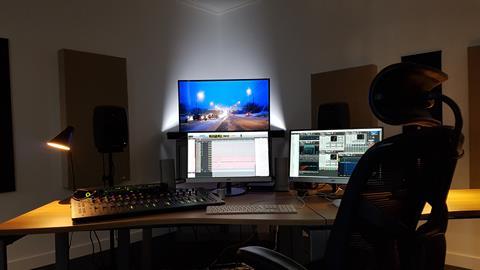A new generation of innovative post-production providers is embracing cloud, virtualisation and remote working to deliver services with a radically-new business model.
Cloud-based post has only now become a reality as developments in public cloud technologies, connectivity and industry software tools have coincided, enabling content to be produced wherever and whenever is needed without carrying the capital cost of an expensive facility.
New creative options are opening up, with increasing flexibility, and cost savings are passed on to clients who themselves need to make budgets stretch further.
Former in-house BBC editor Eben Clancy set up Phantom Sun two years ago at MediaCityUK in Salford with the concept of “pop-up” post-production.

“We pioneered remote editing using cloud services when we worked on Bear Grylls Survival School for ITV Studios producer Potato, who wanted to use their own office space for editing,” Clancy explains.
“Producers are 100% looking to save costs and avoid paying for fancy rooms in a post-house,” he adds. “We can quickly convert a regular office into a post-suite with a connection and portable acoustic panels and lighting. Recently we were doing seven edits, five offlines, a grade and dub without needing any physical space of our own.”
The ability to downsize the fixed costs of the facility is a crucial part of the cloud post-production business model.
“I feel like we’re right at the beginning of a new revolution” - Eben Clancy
While the price of technology has plunged, rents in production hotspots like Soho in London have soared. Traditional post houses risk paying for space even when work is scarce, yet cannot always take on additional jobs when they are busy.
This was the challenge facing Simon Green when planning an equipment refresh at Green Rock, the business he set up nine years ago, originally based on in-house Final Cut Pro suites.

“Our previous bolt-on approach made troubleshooting difficult. I wanted to rip everything out and start again,” says Green.
“I thought ‘what is the industry going to look like in five or six years’ time,’ and it made no sense to buy new kit outright. I started with a clean sheet: moving from FCP to Adobe Premiere and from
Macs to PCs, and started on our journey to the cloud.”
Green Rock implemented BASE Media Cloud’s storage-as-a-service solution for content backup, cutting the costs of managing on-premise servers.
“It avoids tying up capital in a dying machine,” says Green.
“The saving we made on not buying a backup server was invested on putting fibre connectivity into our building” - Simon Green
After 14 years as CTO at Electric Sky Group, Jon Lee knew the potential for cloud solutions to manage digital content without needing huge capital investments.
After trying some early but immature virtual tools, Lee finally felt cloud had come of age when he founded Virtual Post in 2014.
“Buying hundreds of thousands of pounds worth of spinning disk seemed crazy, compared with storage-as-a-service at the end of a decent internet connection,” he says.
IBC365 Webinars: Making media operations work in the cloud
Public versus private
For Virtual Post’s distribution servicing business, Lee built a private-cloud content management system based on Vidispine with a custom UI – enabling clients to manage content catalogues and fulfil distribution orders on a pay-as-you-go basis.
“Vidispine was very much chosen as it’s already built for AWS and the public cloud,” explains Lee. “We will switch to public cloud storage when our clients are ready. There’s still that perception of security, but media companies are more and more willing to accept public cloud.”
For content post-production work, Virtual Post is working with BASE Media Cloud and BeBop Technology, and cloud tools including Frame.io for collaboration, sign-off, and integration with Avid and Adobe editing.
Lee is developing the cloud toolkit further. “We are building a platform to stitch everything together, wrapping up tools and workflow management,” he says.
Industry consultant Jake Robbins put theory into practice with the launch of ThreeFour Media, building cloud-based workflows to streamline transcoding operations, QC, compliance editing and audio work.
“We designed a workflow to take content from the client’s Amazon S3 bucket into ours, where it’s QC checked, edited, transcoded, and delivered to an end-customer – all in the cloud, without touching a user terminal at all,” explains Robbins.

Business growth at Green Rock is also coming from embracing completely cloud-based operations.
“If we want to grow, we don’t want to add on costs, we don’t want more buildings, more edit suites. Cloud gives us huge scalable capacity, speed and flexibility to serve clients – without adding overheads,” says Simon Green.
“We can pitch for bigger shows and offer a more attractive price point because the clients aren’t paying for Soho rents,” he adds.
A common feature of cloud post-production is the ability to tap into a large pool of craft talent working remotely, often from their own home-based facility.
Green Rock is making extensive use of Adobe Team Projects to manage workflows and allow sections of a project to be worked on remotely and synced up later.
“For our clients, it’s the flexibility of not having to be in one central location, tied up in a four-day audio mix or grade. Collaboration and sign-off can be done remotely. And because the talent doesn’t need to travel into central London every day, they can do much better work,” says Virtual Post’s Jon Lee.
Clients are also able to use their own staff on projects, collaborating on equal terms with post-production teams.
This hybrid workflow is popular with ThreeFour Media’s clients.
“The distributor’s own staff may do the work, but via our portal. The client and post-house work really well together,” says Jake Robbins.
This approach enables content to be repurposed profitably for platforms like YouTube.
“We’re more cost effective because we only need small premises and can dial-up Adobe and transcode instances when we need them. It’s very much a pay-as-you-go model,” Robbins explains.
Phantom Sun’s clients have discovered additional gains.
“We’ve found hidden benefits for producers. By using remote working we’re able to condense the process, doing finishing earlier and letting the series producer review online. This allows them to scale down the production team sooner,” Eben Clancy says.

Green Rock is finding the lower cost base is opening up new markets, particularly for digital, marketing and brand content where the demand for high-quality video is growing fast, and benefits from the story-telling experience of broadcast post-production teams.
Bandwidth availability and cost remains the biggest barrier to a wholesale shift to cloud-based post. Installing commercial-grade connectivity with guaranteed capacity and low latency can be disproportionately expensive.
In fact, home internet connections can offer better performance at significantly lower cost – one reason that remote talent working from home studios is a central part of most virtualised post operations.
A new revolution
ThreeFour Media’s Jake Robbins is finding ways to virtualise and deploy “on-premise” tools like Snell’s Alchemist format and framerate converter. “The challenge is getting these technologies running in the cloud and scaling them,” he says.
Virtual Post is solving many of the remaining hurdles and is currently trialling full remote editing, with the aim of launching this to clients within six months, as Jon Lee explains.
“We’re looking now at the use cases and user experience. Rather than relying on editors having their own kit, we’ll manage Avid and Adobe centrally, and they’ll have a window into our systems.”
With producers seeing cost and creative benefits, and technology maturing to make virtualised post-production a working reality, the post industry is changing forever.
“The days of having large sweatshops full of edit rooms in one place are numbered,” predicts Jon Lee.
“There’s an absolute inevitability that this is going to happen. We’re just getting on and doing it,” says Simon Green.
IBC2017 Simon Green will join a panel of broadcasters, media and tech companies from Google Cloud, ITV, and Fox Networks at the Conference to debate “Cloud: how far can it go?” on Friday 15 September, 10.40am in the Forum.
























No comments yet